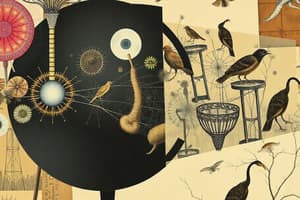Podcast
Questions and Answers
What is the main function of the dorsal respiratory group of neurons?
What is the main function of the dorsal respiratory group of neurons?
- Initiating expiratory activity
- Generating respiratory rhythm (correct)
- Facilitating coordination between the brain hemispheres
- Controlling the rate and depth of breathing
Which of the following statements regarding the ventral respiratory group is correct?
Which of the following statements regarding the ventral respiratory group is correct?
- It is responsible for the generation of respiratory rhythm.
- It contains only expiratory neurons.
- It provides motor control for inspiratory and expiratory muscles. (correct)
- It is located in the dorsal portion of the medulla.
Where is the pneumotaxic center located?
Where is the pneumotaxic center located?
- In the dorsal aspect of the brain stem
- In the superior portion of the pons (correct)
- In the ventrolateral part of the pons
- In the medulla oblongata
What primarily adjusts the rate of alveolar ventilation to the body's demands?
What primarily adjusts the rate of alveolar ventilation to the body's demands?
Which nuclei in the ventral respiratory group are active during exhalation?
Which nuclei in the ventral respiratory group are active during exhalation?
Which group of neurons causes expiration primarily?
Which group of neurons causes expiration primarily?
Which part of the brain contains the respiratory centers that control breathing?
Which part of the brain contains the respiratory centers that control breathing?
What is the role of the dorsal respiratory group in relation to the ventilatory response?
What is the role of the dorsal respiratory group in relation to the ventilatory response?
What primary role does the pneumotaxic center play in respiratory regulation?
What primary role does the pneumotaxic center play in respiratory regulation?
Which chemical constituent primarily stimulates the central chemoreceptors?
Which chemical constituent primarily stimulates the central chemoreceptors?
What mechanism leads to the generation of action potentials in peripheral chemoreceptors during hypoxia?
What mechanism leads to the generation of action potentials in peripheral chemoreceptors during hypoxia?
What percentage of increased ventilation is attributed to central chemoreceptors?
What percentage of increased ventilation is attributed to central chemoreceptors?
Which of the following is NOT a function of peripheral chemoreceptors?
Which of the following is NOT a function of peripheral chemoreceptors?
Why are central chemoreceptors not stimulated directly by increased hydrogen ion concentration in blood?
Why are central chemoreceptors not stimulated directly by increased hydrogen ion concentration in blood?
What initiates the respiratory response sent by central chemoreceptors to the dorsal respiratory group?
What initiates the respiratory response sent by central chemoreceptors to the dorsal respiratory group?
Which location is associated with peripheral chemoreceptors?
Which location is associated with peripheral chemoreceptors?
What immediate effect does increased pCO2 have on respiration?
What immediate effect does increased pCO2 have on respiration?
What type of nerve endings do chemoreceptors utilize in response to blood composition changes?
What type of nerve endings do chemoreceptors utilize in response to blood composition changes?
Study Notes
Regulation of Breathing/Respiration
- Respiration regulation occurs through two mechanisms: Nervous (Neural) and Chemical.
Nervous (Neural) Mechanism
- The nervous system adjusts alveolar ventilation based on body demands.
Respiratory Centers
- Composed of neuron groups in medulla oblongata and pons.
- Three major neuron groups:
- Dorsal Respiratory Group: Located in the dorsal medulla, responsible for inspiration.
- Ventral Respiratory Group: Found in the ventrolateral medulla, responsible for expiration.
- Pneumotaxic Center: Located in the pons, regulates breathing rate and depth.
Dorsal Respiratory Group
- Key player in generating respiratory rhythm, primarily responsible for inspiration.
Ventral Respiratory Group
- Contains both inspiratory and expiratory neurons.
- Active in the initiation of breathing during physical exertion.
Pneumotaxic Center
- Regulates air intake per breath by adjusting activity of the dorsal respiratory group based on the body's needs.
Chemical Mechanism
- Operates through chemoreceptors responding to blood chemical changes.
Chemoreceptor Stimuli
- Hypoxia: Decreased oxygen levels (pO2).
- Hypercapnea: Increased carbon dioxide levels (pCO2).
- Increased hydrogen ion concentration increases respiratory drive.
Types of Chemoreceptors
- Central Chemoreceptors: Located in the brain; responsible for 70-80% of increased ventilation.
- Peripheral Chemoreceptors: Found in carotid and aortic regions; respond primarily to hypoxia.
Mechanism of Action of Central Chemoreceptors
- Connected to respiratory centers; respond to increased hydrogen ions generated by carbonic acid from elevated CO2.
- Excitatory impulses sent to the dorsal respiratory group, increasing ventilation (rate and force of breathing).
Mechanism of Action of Peripheral Chemoreceptors
- Hypoxia strongest stimulant, activating oxygen-sensitive potassium channels in glomus cells.
- Closure of potassium channels leads to depolarization and action potential generation, enhancing nerve signaling to the dorsal respiratory group.
- Results in increased ventilation to correct oxygen deficiency.
Studying That Suits You
Use AI to generate personalized quizzes and flashcards to suit your learning preferences.
Description
This quiz explores the two primary mechanisms that regulate respiration: the nervous or neural mechanism and the chemical mechanism. Understand how the respiratory centers in the brain adjust ventilation according to the body's needs.




